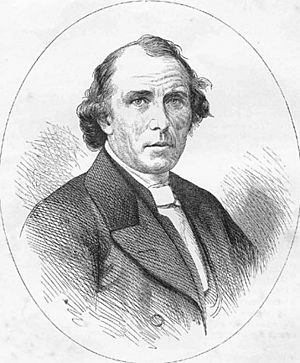Joseph Decaisne facts for kids
Joseph Decaisne (born March 7, 1807 – died January 8, 1882) was a French botanist and agronomist. A botanist studies plants, and an agronomist studies how to grow crops and manage soil. Joseph Decaisne started as an assistant to Adrien-Henri de Jussieu, who was a professor of rural botany. During this time, he began studying plants brought back by travelers, like those from Victor Jacquemont who explored Asia. Decaisne focused on practical research, especially on how to grow plants like the madder (used for dyes), the yam, and the ramie (used for fiber). He was also very interested in algae, which are simple plant-like organisms.
Joseph Decaisne's Life Story
Joseph Decaisne was born in Brussels, Belgium, but he did all his important work in Paris, France. In 1824, he started working as a gardener at the Muséum national d'histoire naturelle, which is a famous French natural history museum. By 1832, he became the head of the section that dealt with planting seeds. He also worked at the Jardin des Plantes, a large botanical garden, and worked with an American botanist named Asa Gray.
In 1847, he became the head of the Statistical Agriculture department at the College de France. This department studied facts and figures about farming.
In 1850, Decaisne took over from Charles-François Brisseau de Mirbel as the head of horticulture (the art of garden cultivation) at the Museum. In 1854, he helped create the Société botanique de France, which is a society for plant scientists in France.
Several groups of plants, called genera, were named in his honor. These include Decaisnea, Decaisnina, and Decaisnella. This shows how important his work was in the world of plants.
Joseph Decaisne passed away in Paris on January 8, 1882.
How He Helped Classify Plants
Joseph Decaisne was very important in plant taxonomy, which is the science of naming, describing, and classifying plants. He identified and described many new types of flowering plants.
For example, he described:
- Capanea and Chrysothemis, which are now part of the Gesneriaceae family (often known for houseplants like African violets).
- Vancouveria (with C.Morren), a type of plant in the Berberidaceae family.
- Fatsia and Dendropanax (with Planch.), which belong to the Araliaceae family.
- Akebia and Boquila, found in the Lardizabalaceae family.
- Galtonia, a plant in the Liliaceae family, which includes lilies.
- Amorphophallus, a unique plant in the Araceae family, known for its large flowers.
- Many types of plants in the Asclepiadaceae family, which includes milkweeds.
His work helped scientists better understand and organize the vast world of plants.
Books and Publications
Joseph Decaisne wrote several important books and collaborated on others. These works helped share his knowledge with other scientists and the public.
- Le jardin fruitier du Museum (The Fruit Garden of the Museum) was a large, nine-volume set published between 1858 and 1875. It was all about fruit trees and how to grow them.
- Traité général de botanique descriptive et analytique (General Treatise of Descriptive and Analytic Botany) was a major book published in 1876 in Paris. He wrote this with Emmanuel Le Maout. An English version was also available in 1873.
- Mexicanas plantas (Plants of Mexico) was a collaborative work published from 1872 to 1886. It described many plants found in Mexico.


